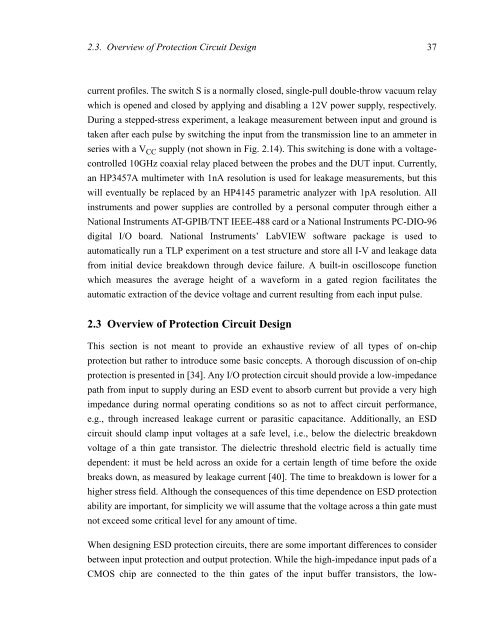characterization, modeling, and design of esd protection circuits
characterization, modeling, and design of esd protection circuits
characterization, modeling, and design of esd protection circuits
Create successful ePaper yourself
Turn your PDF publications into a flip-book with our unique Google optimized e-Paper software.
2.3. Overview <strong>of</strong> Protection Circuit Design 37<br />
current pr<strong>of</strong>iles. The switch S is a normally closed, single-pull double-throw vacuum relay<br />
which is opened <strong>and</strong> closed by applying <strong>and</strong> disabling a 12V power supply, respectively.<br />
During a stepped-stress experiment, a leakage measurement between input <strong>and</strong> ground is<br />
taken after each pulse by switching the input from the transmission line to an ammeter in<br />
series with a VCC supply (not shown in Fig. 2.14). This switching is done with a voltagecontrolled<br />
10GHz coaxial relay placed between the probes <strong>and</strong> the DUT input. Currently,<br />
an HP3457A multimeter with 1nA resolution is used for leakage measurements, but this<br />
will eventually be replaced by an HP4145 parametric analyzer with 1pA resolution. All<br />
instruments <strong>and</strong> power supplies are controlled by a personal computer through either a<br />
National Instruments AT-GPIB/TNT IEEE-488 card or a National Instruments PC-DIO-96<br />
digital I/O board. National Instruments’ LabVIEW s<strong>of</strong>tware package is used to<br />
automatically run a TLP experiment on a test structure <strong>and</strong> store all I-V <strong>and</strong> leakage data<br />
from initial device breakdown through device failure. A built-in oscilloscope function<br />
which measures the average height <strong>of</strong> a waveform in a gated region facilitates the<br />
automatic extraction <strong>of</strong> the device voltage <strong>and</strong> current resulting from each input pulse.<br />
2.3 Overview <strong>of</strong> Protection Circuit Design<br />
This section is not meant to provide an exhaustive review <strong>of</strong> all types <strong>of</strong> on-chip<br />
<strong>protection</strong> but rather to introduce some basic concepts. A thorough discussion <strong>of</strong> on-chip<br />
<strong>protection</strong> is presented in [34]. Any I/O <strong>protection</strong> circuit should provide a low-impedance<br />
path from input to supply during an ESD event to absorb current but provide a very high<br />
impedance during normal operating conditions so as not to affect circuit performance,<br />
e.g., through increased leakage current or parasitic capacitance. Additionally, an ESD<br />
circuit should clamp input voltages at a safe level, i.e., below the dielectric breakdown<br />
voltage <strong>of</strong> a thin gate transistor. The dielectric threshold electric field is actually time<br />
dependent: it must be held across an oxide for a certain length <strong>of</strong> time before the oxide<br />
breaks down, as measured by leakage current [40]. The time to breakdown is lower for a<br />
higher stress field. Although the consequences <strong>of</strong> this time dependence on ESD <strong>protection</strong><br />
ability are important, for simplicity we will assume that the voltage across a thin gate must<br />
not exceed some critical level for any amount <strong>of</strong> time.<br />
When <strong>design</strong>ing ESD <strong>protection</strong> <strong>circuits</strong>, there are some important differences to consider<br />
between input <strong>protection</strong> <strong>and</strong> output <strong>protection</strong>. While the high-impedance input pads <strong>of</strong> a<br />
CMOS chip are connected to the thin gates <strong>of</strong> the input buffer transistors, the low-
















